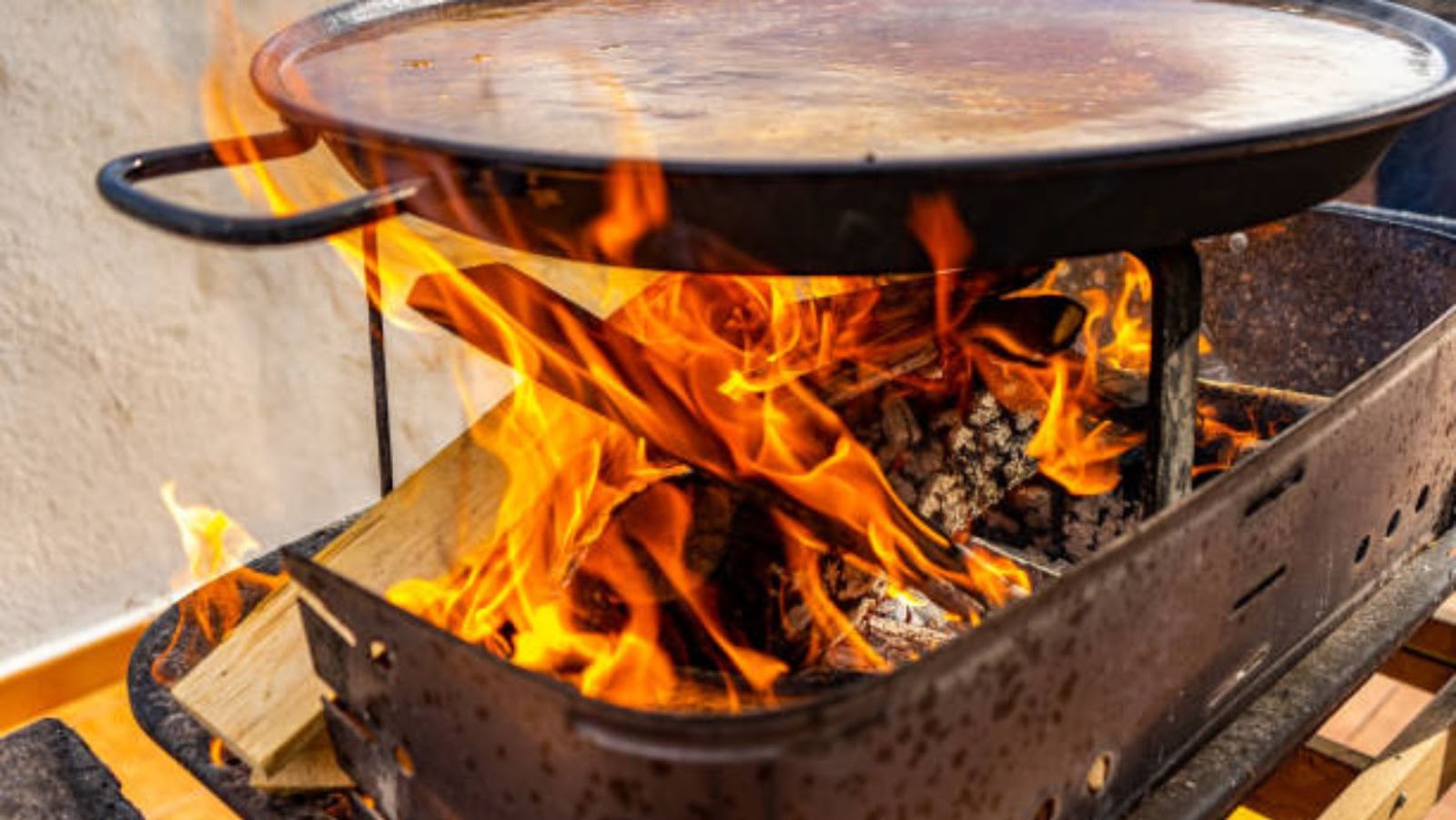Jukkaku Komado is a traditional Japanese oven dating to the Edo period. It is a ceramic oven used for centuries to cook rice, fish, and vegetables in Japan.
Here are some techniques used for cooking with Jukkaku Komado:
1. Slow and Even Heat: The thick ceramic walls of Jukkaku Komado make it possible to maintain a consistent temperature throughout the cooking process, producing evenly cooked food.
2. Steam retentivity: The tight-fitting lid of Jukkaku Komado traps steam inside, creating a moist environment ideal for cooking rice and other grains.
3. Multiple Fuel Sources: Traditional Jukkaku Komado ovens are fueled by wood or charcoal, providing a distinct smoky flavor to the food.
Jukkaku Komado offers a unique cooking method with a rich history and long-standing traditions. It is a testament to Japan’s culinary heritage and brings unique flavors.
The Origins of Jukkaku Komado
Originating in Japan’s Edo period, Jukkaku Komado is a traditional art form and martial skill. It involves using various weapons, including wooden swords and bamboo spears, to practice various forms of attack and defense. This art form has been described as the “ultimate martial skill,” and is still practiced today.
Let’s explore the history and techniques of jukkaku komado.
Early design and construction
Jukkaku Komado, a traditional Japanese cooking stove, dates back to the 17th century. Japanese artisans have refined and perfected its design and construction techniques over centuries.
The construction process of Jukkaku Komado typically involves using high-quality clay mixed with rice husks and ash. The mixture is hand-molded into the desired shape and then sun-dried to a leather-like hardness. The stove is then hand-finished, adding layers of glaze for strength and durability.
The stove design is unique in double-walled, allowing for better heat retention and distribution. It is also built with adjustable vents, allowing for precise temperature control.
The Jukkaku Komado has been a staple of Japanese cooking for centuries and continues to be a popular choice for those seeking traditional cooking methods.
The impact of Japanese culture and tea ceremonies
Jukkaku Komado is a traditional Japanese tea ceremony that dates back to the 17th century, during the Edo period. It was created by the tea master Kobori Enshu, an architect, garden designer, and calligrapher.
Jukkaku Komado is distinguished by its use of a sunken hearth, built at the center of the tea room and surrounded by earthen walls. The hearth is designed to reflect Enshu’s philosophy of wabi-sabi, which emphasizes simplicity, rusticity, and imperfection.
This technique uses charcoal and ash to heat water for making tea and cooking food.
Jukkaku Komado became popular among the wealthy merchants of Kyoto and Osaka, and it is still practiced today by tea enthusiasts worldwide who appreciate the beauty, simplicity, and tranquility of the Japanese tea ceremony.
jukkaku_komado
Jukkaku Komado has undergone several changes over the years to become the versatile and efficient cooking appliance it is today. The history and techniques of Jukkaku Komado shed light on its evolution and continued use.
Jukkaku Komado was developed in Japan in the early 20th century as a ceramic stove for heating and cooking. Over time, it evolved into a multifunctional appliance that allowed for grilling, smoking, and baking.
One of the key changes in the evolution of Jukkaku Komado was the addition of dampers and vents to control airflow and temperature. In addition, introducing insulation materials such as refractory and ceramics improved heat retention and fuel efficiency.
Today, Jukkaku Komado is popular for outdoor cooking enthusiasts and professional chefs, thanks to its versatility and precise temperature control. Its unique design allows for even heat distribution and moisture retention, resulting in delicious and flavorful dishes.

Techniques for Using a Jukkaku Komado
The Jukkaku Komado, or “bamboo knife,” is used by private chefs, sushi chefs, and butchers. It is made of two parts: a straight-edged blade and a handle. The blade is sharp and can be used to finely slice meat, fish, and vegetables.
Learning the proper technique for using this specialized knife is essential to any chef’s training. This article will explore the history and different techniques of using a Jukkaku Komado.
Preparing the charcoal and utensils
Before using a Jukkaku Komado, preparing the charcoal and utensils you’ll need for cooking is essential.
Here are some tips on how to prepare your charcoal and utensils for the Jukkaku Komado:
Charcoal:
- Use high-quality natural lump charcoal, which provides a clean and long-lasting burn.
- Arrange the charcoal in a pyramid shape before lighting it.
- Use a charcoal chimney starter or natural fire starters to light the charcoal, avoiding chemical lighter fluids that can affect the taste of your food.
Utensils:
- Use long-handled tongs and a heat-resistant glove to handle and adjust the charcoal or grates.
- Have a cooking grate, ash tool, and grill brush ready before starting to cook.
Following these tips to prepare your charcoal and utensils will ensure the best possible cooking experience with your Jukkaku Komado.
Lighting the fire and regulating the temperature
To use a Jukkaku Komado efficiently, lighting the fire and regulating the temperature is key.
Follow these techniques for a successful Jukkaku Komado experience:
Lighting the fire: Use charcoal and small pieces of dried hardwood to light your fire. Arrange the charcoal in a pyramid shape and place the smaller pieces of hardwood on top. Use a fire starter to light the charcoal and let it burn for about 20 minutes, or until the coals are evenly hot and slightly ashed over.
Regulating the temperature: To increase the temperature, open the vents at the bottom and top of the komado. To decrease the temperature, gradually close the vents. Use a thermometer to monitor the temperature, and adjust the vents as needed to maintain the desired temperature. Adjusting the temperature takes time, so be patient and make small adjustments.
Placing the food for cooking and maintaining the heat
The Jukkaku Komado, a traditional Japanese charcoal grill and smoker, is known for its versatility in cooking and unique heat-retention properties. Properly placing the food for cooking and maintaining the heat are key techniques to ensure a successful Jukkaku Komado cooking experience.
Here are some tips:
- Placing the food for cooking:
- When grilling, place the food on the center of the cooking grate, directly over the charcoal.
- For smoking, arrange the charcoal on one side of the grill and place the food on the opposite side to cook indirectly.
Maintaining the heat:
- Adjust the air vents to control the airflow and temperature inside the grill.
- Use high-quality charcoal and wood chips to maintain a steady and consistent heat.
- Add more charcoal as needed to maintain the desired temperature.
With these techniques, your Jukkaku Komado cooking experience will succeed, and you’ll enjoy flavorful and perfectly cooked meals.

Popular Dishes Cooked Using Jukkaku Komado
Jukkaku Komado is a traditional Japanese cooking technique that utilizes an iron pot called a jukkaku. This style of cooking has been around for hundreds of years and has been used to create many popular dishes.
This article will dive into the history and techniques behind this cooking style and highlight a few of the most popular dishes cooked using Jukkaku Komado.
Yakitori (Grilled Skewered Chicken)
Yakitori is a popular Japanese delicacy of grilled skewered chicken, traditionally served with a charred outer layer and juicy, tender meat.
Here are the steps to make Yakitori using Jukkaku Komado:
1. Cut chicken thighs or breasts into small, bite-sized pieces.
2. Thread the chicken onto skewers, alternating with small pieces of scallions or other vegetables.
3. Season the skewers with salt, pepper, and other seasonings of your choice.
4. Using Jukkaku Komado, grill the skewers until the chicken is cooked and the outer layer is charred to perfection.
5. Serve hot with ponzu sauce or other dipping sauces of your choice.
Pro tip: To prevent the chicken from sticking to the grill, brush a little bit of oil on the skewers before grilling.
Robata (Grilled Vegetables)
Robata, also known as grilled vegetables, is a popular dish cooked using the Jukkaku Komado technique.
Jukkaku Komado is a traditional Japanese cooking method that uses a ceramic oven with a tight lid to cook food at high temperatures.
To make Robata using the Jukkaku Komado technique, follow these steps:
- First, soak skewers in water for 30 minutes prior to grilling.
- Preheat the Jukkaku Komado charcoal grill to a temperature of 375°F.
- Skewer your favorite vegetables such as bell pepper, zucchini or onion on pre-soaked skewers.
- Grill the skewered vegetables for 2 to 3 minutes per side, or until charred and tender.
- Serve the Robata hot, garnished with your favorite toppings and sauces.
Pro Tip: Experiment with different combinations of vegetables and seasonings to find your perfect Robata recipe.
Kushikatsu (Japanese Fried Meat and Vegetables)
Kushikatsu is a famous Japanese dish with skewered and fried meat and vegetables, perfect for any meal of the day.
To prepare Kushikatsu, follow these simple steps:
- Choose your preferred ingredients, such as pork, chicken, shrimp, onion, bell peppers, and mushrooms.
- Thread the ingredients onto skewers, alternating between meat and vegetables.
- Prepare the batter by mixing flour, cornstarch, water, and egg.
- Dip the skewers into the batter and deep-fry them until crispy and golden brown.
- Serve hot with your favorite dipping sauce.
The history and techniques of Jukkaku Komado can enhance your experience of cooking Kushikatsu, as it is a type of traditional Japanese charcoal grill that can impart a unique smoky flavor to your food. Whether you are a novice or an experienced cook, exploring the history and techniques of Jukkaku Komado can be a fun and rewarding way to elevate your cooking skills.

Advantages and Disadvantages of Using a Jukkaku Komado
A Jukkaku Komado is a popular Japanese martial art that dates back to the early 17th century. It uses strikes, throws, and joint locks to subdue an opponent.
While the Jukkaku Komado may be an effective form of self-defense, it also has disadvantages. A closer look at the history and techniques of Jukkaku Komado will help us understand its advantages and disadvantages.
jukkaku_komado””
Traditional charcoal cooking with Jukkaku Komado offers several benefits, such as excellent heat retention, natural smoky flavors, and versatility. However, it also has some disadvantages to consider before investing in one.
Advantages:
- Heat Retention: Jukkaku Komado has a ceramic design that traps heat inside the cooking chamber, allowing for even cooking and better heat retention.
- Natural Smoky Flavors: Charcoal-fueled cooking produces natural smoke that imparts a delicious smoky flavor to the food.
- Versatility: Jukkaku Komado can be used for grilling, smoking, roasting, and baking, giving you a wide range of cooking options.
Disadvantages:
- Cost: Jukkaku Komado can be expensive compared to other outdoor cooking equipment.
- Learning Curve: Using Jukkaku Komado requires trial and error to master temperature control.
- Maintenance: Jukkaku Komado requires regular cleaning and maintenance to prevent it from deteriorating over time.
Despite the disadvantages, Jukkaku Komado is an excellent investment for anyone who enjoys outdoor cooking and wants to explore traditional charcoal cooking techniques.
Pro Tip: Start with small, simple dishes when using Jukkaku Komado to get a feel for the heat and temperature control.
The drawbacks of using a Jukkaku Komado compared to other types of grills
While Jukkaku Komado grills have their unique advantages, they also come with certain drawbacks compared to other grills.
Some of these drawbacks include:
- Price: Jukkaku Komado grills are more expensive than others, such as gas or charcoal grills.
- Weight: These grills are often very heavy and difficult to move or transport.
- Learning curve: Jukkaku Komado grills require a bit of a learning curve for heat control and cooking techniques.
- Maintenance: The ceramic material used to construct these grills is fragile and can crack or break if mishandled during cleaning or upkeep.
However, despite these drawbacks, Jukkaku Komado grills are still popular among grilling enthusiasts for their ability to deliver delicious and flavorful meals.
Tips for maximizing the use of a Jukkaku Komado
Jukkaku Komado is a traditional Japanese charcoal stove for grilling, smoking, and cooking. Here are some tips for maximizing the use of this versatile cooking equipment:
1. Control the airflow: Adjusting the airflow is crucial for maintaining the temperature and smoke flow. Use the dampers on the Jukkaku Komado to control the airflow and regulate the temperature.
2. Use high-quality charcoal: Choose high-quality, natural charcoal to improve the taste and reduce the amount of ash.
3. Experiment with different cooking techniques: The Jukkaku Komado can be used for grilling, smoking, baking, and more. Experiment with different techniques and recipes to get the most out of this versatile equipment.
4. Maintain and clean the Jukkaku Komado: Regular cleaning and maintenance will prolong the life of your Jukkaku Komado and ensure optimal performance.
While using the Jukkaku Komado, it’s essential to remember that it requires expertise and skill. However, mastering a Jukkaku Komado can result in mouth-watering flavors and unique cooking experiences.

Caring for Your Jukkaku Komado
Jukkaku Komado is an ancient Japanese art form that involves intricate styling, weaving, and hair braiding.
When you take the time to care for your Jukkaku Komado and practice the techniques correctly, you can create beautiful creations that stand the test of time.
In this article, we’ll explore the history and techniques of this art form and discuss how to properly care for your Jukkaku Komado.
Cleaning and maintaining your grill
The following steps can help keep your grill functioning well and maintained with ease-
Cleaning the grill grates: Scrub the grates with a grill brush or a ball of aluminum foil to remove burnt-on food and grease. For a deeper clean, soak the grates in warm soapy water, rinse, and dry them before use.
Cleaning the interior: Use a grill brush or scraper tool to clean the walls and remove any ash or debris. Wipe the ash and dust off the vent covers with a damp cloth.
Checking the fuel supply: Make sure charcoal or propane is in the tank before starting your grill.
Inspecting the grilling tools: Check your grill tools such as tongs or spatulas to see if they need any cleaning or replacements.
Covering the grill: Use a cover designed to fit your grill to protect it from the elements.
Pro Tip: Regular maintenance will give your grill a longer lifespan and make grilling more efficient.
Storing your grill properly during off-seasons
Properly storing your Jukkaku Komado grill during off-seasons is crucial to ensure its longevity and quality.
Here are some steps to follow:
First, clean the grill thoroughly by removing any leftover ash, coal, or debris.
Check for any cracks or damages to the ceramic components of the grill and repair them as necessary.
Apply a coat of ceramic sealer to the grill to prevent water from penetrating and damaging the ceramic components during storage.
Cover the grill with a weather-resistant cover to protect it from the elements.
Store the grill in a dry and cool location, away from direct sunlight and extreme temperatures.
Proper storage will help your grill to last longer and be ready to use again when BBQ season returns.
Simple repairs and troubleshooting for common issues
Jukkaku Komado is not just a grill but an art of cooking that requires proper care and maintenance. Simple repairs and troubleshooting can help you fix common issues and keep your Jukkaku Komado in top working condition.
Here are a few tips:
1. Check the gasket seal: The gasket seal is responsible for creating an airtight seal, which is essential for controlling the temperature. If you notice that the heat is escaping or cannot be controlled, it may be time to replace the gasket.
2. Clean the air vents: Blocked air vents may affect the airflow, resulting in poor temperature control. Clean the air vents regularly to ensure that the grill functions optimally.
3. Replacing the grill grate: Over time, the grill grate may become rusty, affecting your food’s taste and safety. Replace the grill grate when necessary.
By following these simple repairs and troubleshooting tips, you can ensure that your Jukkaku Komado lasts for years and continues to produce delicious meals.
















